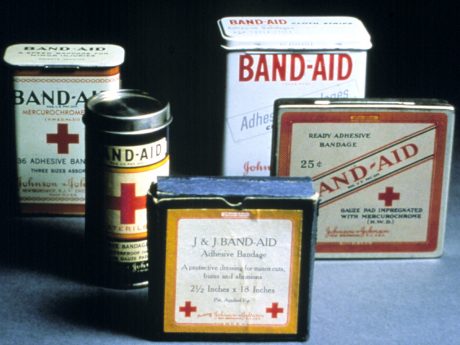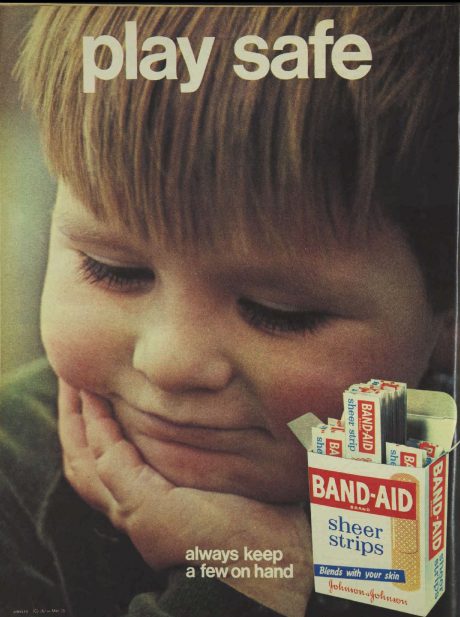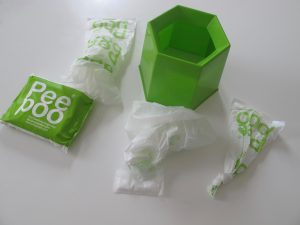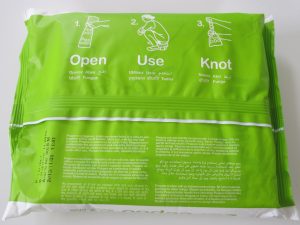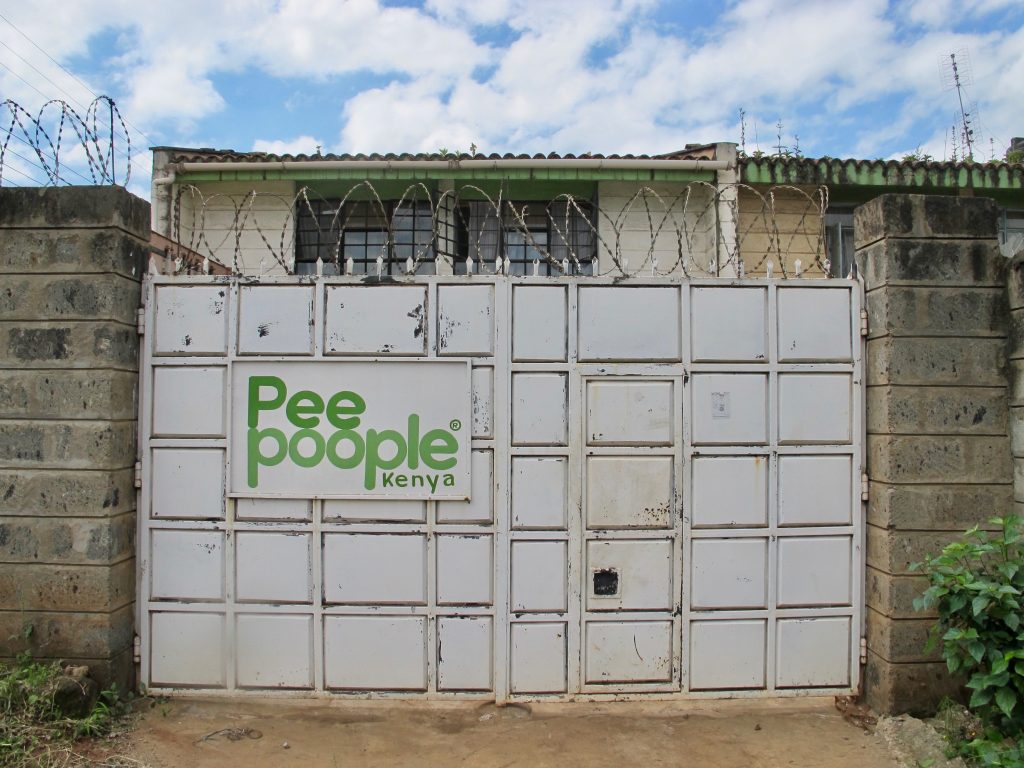“Suppose you have a cut on your finger. Cut a piece of Band-Aid from the strip, pull off the face-cloth and put the bandage over the wound. That’s all there is to it. The bandage will stay right where you place it without tying. Can you imagine anything handier for the household or shop?” — The Red Cross Messenger[1]
“New situations demand new magic.” (Evans-Pritchard 1937: 513)
The origin of the humble Band-Aid offers enticing material for corporate legend. In 1920, Earle Dickson was a cotton buyer for the medical supply company known as Johnson & Johnson in New Brunswick, New Jersey. Dickson, the story goes, had an accident-prone young wife named Josephine. Concerned about her tendency to acquire small injuries in the course of daily routines, he created an ingenious solution: a prepared set of strips combining sterile gauze, surgical tape and a crinoline fabric cover to keep it clean until use. Now, when his wife needed a dressing, she could simply take a strip, cut it to length, peel off the fabric and apply it herself. Minor wound care moved into the domain of self-treatment, a selling point that eventually convinced Dickson’s employer to begin marketing it the following year. After a slow start, the new bandage caught on. The company displayed enough marketing imagination to distribute it for free to Boy Scout troops across the country, and by 1924 had begun to offer machine-cut Band-Aids in multiple sizes.
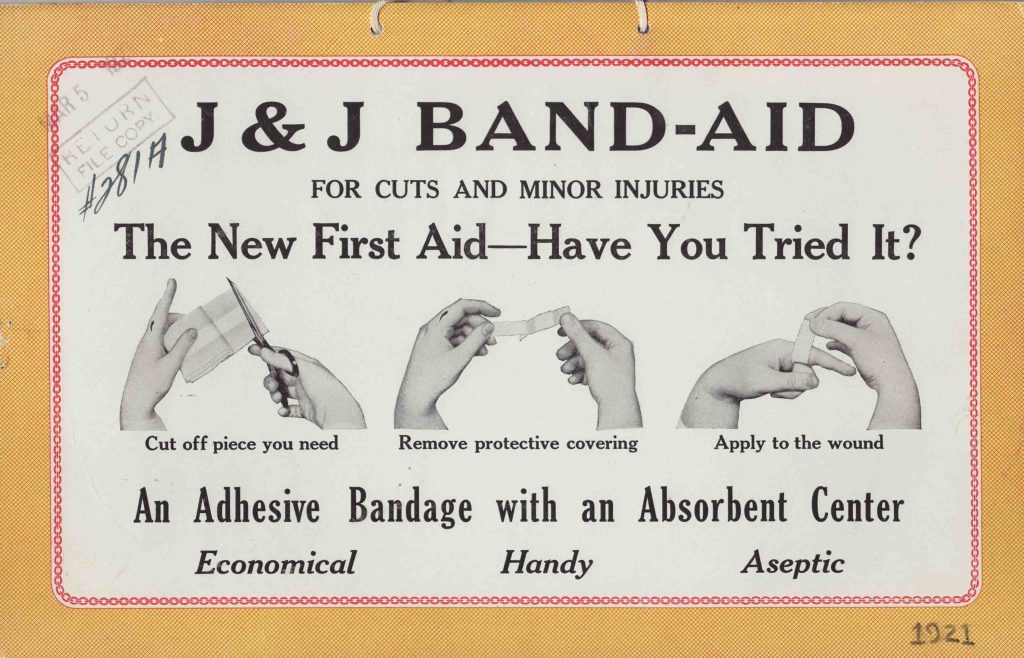
BAND-AID® Brand Adhesive Bandage ad from 1920, showing the product as Earle Dickson invented it. Image: Johnson & Johnson Archives.
At the time of Dickson’s innovation, Johnson & Johnson was already a well-established and innovative enterprise. The company derived from the labors of three industrious brothers of that name, the eldest of whom, Robert Wood, had trained as an apothecary. Inspired by the surgeon Joseph Lister’s crusade for the merits of sterile surgery, he had gone into business with a fellow hygiene enthusiast, George Seabury, to create medical plasters and surgical dressings. In 1885 he joined his brothers in manufacturing ready-to-use dressings, and what came to be known as first-aid kits. By 1888, their product list included “accident and emergency cases” for antiseptic treatment, available in several sizes. After surveying railway surgeons across the country about their needs, the company launched a “railway station and factory supply case” containing a set of equipment that would enable station agents to respond to emergencies. In 1898 Johnson & Johnson supplied a “first aid packet” for soldiers fighting for the United States in the Spanish-American War, and in 1901 began producing first-aid instruction manuals. The range of kits on offer only would continue to grow with new transport inventions, like the automobile and airplane.[2] War was good to Johnson & Johnson. If not yet a fully transnational behemoth, it found ample opportunity in the mass suffering of European trenches even before the United States joined the First World War. At the close of the conflict, the company stood poised for new things, and the migration of bandages from battlefield to kitchen offered an expanding domestic front.[3]
A deeper history of wound care might complicate this story, adding rival accounts and antecedents of packaged dressings and plasters, as well as shifting conceptions of risk. (See Tarr and Tebeau 1997 for more on concern about “accidents” in early 20th-century America.) Likewise, a wider account of the rise of mass consumption and marketing might situate this particular story within a broad pattern of commodity domestication, such as campaigns to put cigarettes into the hands of women (Brandt 1996). Nonetheless, the corporate arc leading to the trademarked product officially known as the Band-Aid provides key elements for analysis. A simple but ingenious innovation, the adhesive bandage enabled the most ordinary and clumsy citizens to treat minor cuts and abrasions quickly and reliably wherever they found themselves. The early 20th century housewife and shop operator each gained new assurance in their mechanized environments, freed from worrying about minor hazards contained in the tools of their trade. Standardized and pre-sterilized, the new strip was mobile while packaged and stable once applied. It was easy to use, durable in action and boasted a long shelf-life. A box of them anticipated future accidents and stood prepared for the next minor emergency. An icon of middle-class safety and hygiene was born: children would grow up receiving quick treatment for mishaps, in increasingly colorful forms. The Band-Aid fits neatly into the first-aid kit, a larger and more capacious assemblage of items with similar intent. Deposited around the landscape of everyday industrial life—houses, cars, boats, offices, airplanes—such kits provided a small cache of prepared supplies available for any need that might suddenly arise. Beyond a lucrative business opportunity for corporations like Johnson & Johnson, these little packets enabled a new norm of quick response. One might even describe them as a minor form of medicalization, redefining small problems through anticipated care. At the very moment cries and finger-pointing might begin, a solution now was already at hand, just awaiting application.
In and of itself, it is hard to argue with a Band-Aid. As anyone who has used one knows, this little strip of adhesive tape and gauze offers an enchantingly simple and reliable response to a small cut, abrasion, blister, or splinter. Once sealed and padded, a minor injury can heal without further interference, causing less distress. If not fully therapeutic, or particularly effective at keeping a wound moist and sterile, the adhesive bandage would at least offer the advantage of protection as well as palliation. (Current medical consensus favors keeping wounds hydrated and covered; see Sood et al. 2014.) Here, at least, it would seem the overflow of 19th-century military and industrial production offered some small benefits to civilian society.
Yet the Oxford English Dictionary records a second entry for the term, describing “a temporary or makeshift solution to a problem,” a merely palliative rather than properly curative result.[4] The connotation of this secondary usage is clearly negative, implying insufficiency and disappointment. Whatever the value of palliation for patient comfort, it does not address underlying causes and can appear unsatisfactory from a therapeutic perspective. Ultimately, a Band-Aid is a modest form of care, one that provides minor relief and minimal hygiene. It offers a poor substitute for a health clinic staffed by experts. No one would, or should, mistake it for a hospital. Moreover, a bandage placed over a poorly cleaned wound risks infection, ultimately concealing a festering sore. This second meaning of the term, then, introduces a dimension of critical distance into what would otherwise appear an innocuous, if not irreproachable good. Is a Band-Aid the right tool for the task? Is it enough? Or might it mask a deeper problem while providing false security?
 This second, critical meaning of the term features prominently in discussions of international aid projects, which include a long history of things that appear superficially beneficial but quickly prove inadequate. Indeed, an entire approach in development and global health might appear cynically insufficient, the smallest palliation in the face of serious need. Such critical, suspicious use of the term invites interrogation, however, given its literal referent in a small, inoffensive adhesive bandage. At what point, and under what conditions, might a Band-Aid transmute from a modest improvement into a deceptive response? When does the inflection shift, from doing “a little good” to “little good”?
This second, critical meaning of the term features prominently in discussions of international aid projects, which include a long history of things that appear superficially beneficial but quickly prove inadequate. Indeed, an entire approach in development and global health might appear cynically insufficient, the smallest palliation in the face of serious need. Such critical, suspicious use of the term invites interrogation, however, given its literal referent in a small, inoffensive adhesive bandage. At what point, and under what conditions, might a Band-Aid transmute from a modest improvement into a deceptive response? When does the inflection shift, from doing “a little good” to “little good”?
To help frame an answer, consider a second metaphorical referent. Like the Band-Aid, the phrase “magic bullet” appears with some frequency in contemporary discussions related to international aid and global health (e.g. Cueto 2013). Frequently, the use in this context is both metaphorical and pejorative, indicating a misguided faith in a would-be technical solution to a socially complex problem. It implies that belief in technology can itself turn into magical thinking, misapprehending the nature of the problem and forgetting larger truths in a quest for simple answers. Indeed, the phrase clearly references European folk tradition, in which a silver bullet might slay a monster such as a werewolf.[5] The silver bullet suggests a fetish of the classic sort, an object thought to possess extraordinary powers by those who believe in it and congealed mystification by those who do not (e.g. Latour 2010; Scott-Smith 2013). At moments of duress, facing a grave threat and the apparent failure of ordinary objects to meet it, magical thinking grows attractive. Surely someone should still act, and “do something”— even when confronting an apparently intractable challenge. The self-appointed task of any critic would then be to dispel fairy tales, unveiling illusions and exposing the false promises of an idol suffused with ontological and epistemological distortions. This is obviously easier to do when occupying a position of certainty and offering an alternative means to deal with whatever lurks beyond the door.
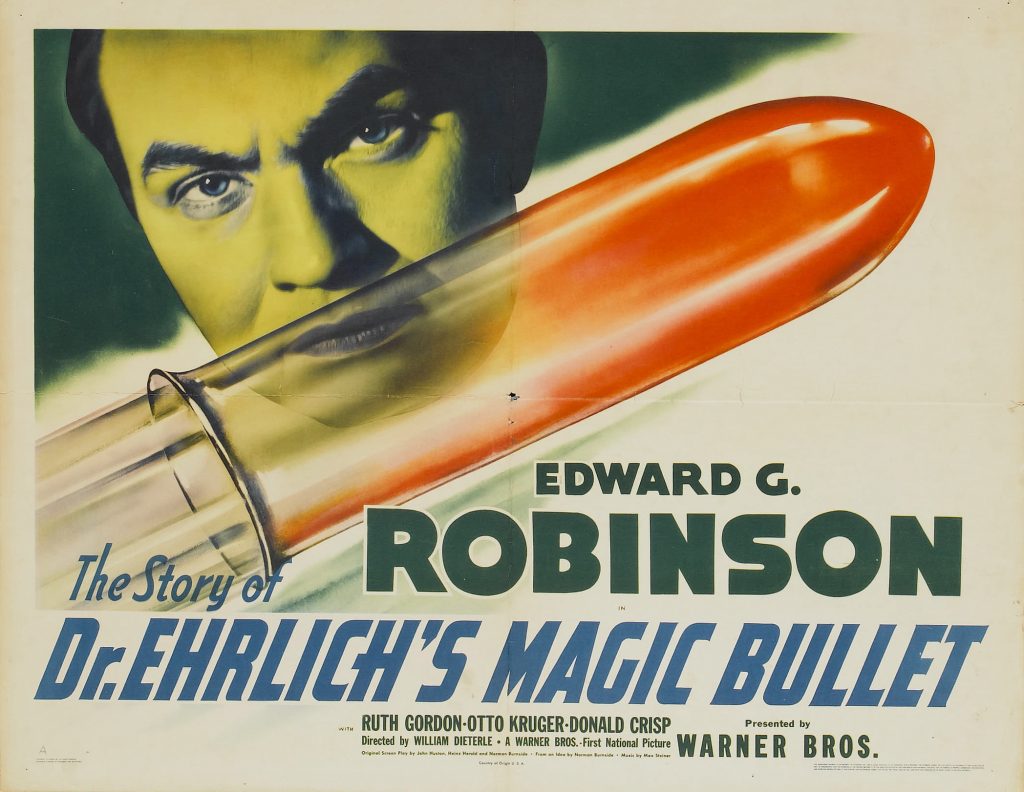 However, in medical history the magic bullet also signals another, positive framing, as a pharmaceutical concept introduced at the outset of the 20th century by the German Jewish scientist Paul Ehrlich of “drugs that go straight to their intended cell-structural targets” (Strebhardt and Ullrich 2008: 1). Ehrlich’s vision of a charmed projectile suggests an alternative basis for allure: the capacity for specific targeting, as demonstrated by the synthetic drug Salvarsan against syphilis. Although anyone familiar with chemotherapy might recognize shortfalls in the current application of this concept in cancer treatment, an updated, genetically informed version of his dream remains very much alive. Targeting enables a different sort of magic — that of altering scale. Narrowing scope reduces the field of reference from macro to micro, permitting tangible, immediate action within a delimited space of encounter. Targeting nonetheless retains a degree of grand ambition. If the right projectile dispatches its werewolf anywhere, at any time, then a path to universality runs precisely through heightened specificity. Targeting also implies a reduction of waste and a minimization of unintended consequences. The objects it creates lend themselves to regimes of audit, testing, and recursive experimentation, while requiring neither mass labor mobilization nor state-level regulatory systems such as prior development regimes. A specific remedy shines brightly with the promise of efficiency. More might be accomplished with less, simply by concentrating the connection between problem and intervention. The contemporary magic bullet, then, may indeed be a fetish but one whose specific qualities of enchantment exemplify the historical moment. For tangibility clearly inspires those working on humanitarian objects and attracts the interest of influential publics. Rather than abstractly “doing good,” it suggests the possibility of making a specific, located, and measurable difference (Good and Good 2012).
However, in medical history the magic bullet also signals another, positive framing, as a pharmaceutical concept introduced at the outset of the 20th century by the German Jewish scientist Paul Ehrlich of “drugs that go straight to their intended cell-structural targets” (Strebhardt and Ullrich 2008: 1). Ehrlich’s vision of a charmed projectile suggests an alternative basis for allure: the capacity for specific targeting, as demonstrated by the synthetic drug Salvarsan against syphilis. Although anyone familiar with chemotherapy might recognize shortfalls in the current application of this concept in cancer treatment, an updated, genetically informed version of his dream remains very much alive. Targeting enables a different sort of magic — that of altering scale. Narrowing scope reduces the field of reference from macro to micro, permitting tangible, immediate action within a delimited space of encounter. Targeting nonetheless retains a degree of grand ambition. If the right projectile dispatches its werewolf anywhere, at any time, then a path to universality runs precisely through heightened specificity. Targeting also implies a reduction of waste and a minimization of unintended consequences. The objects it creates lend themselves to regimes of audit, testing, and recursive experimentation, while requiring neither mass labor mobilization nor state-level regulatory systems such as prior development regimes. A specific remedy shines brightly with the promise of efficiency. More might be accomplished with less, simply by concentrating the connection between problem and intervention. The contemporary magic bullet, then, may indeed be a fetish but one whose specific qualities of enchantment exemplify the historical moment. For tangibility clearly inspires those working on humanitarian objects and attracts the interest of influential publics. Rather than abstractly “doing good,” it suggests the possibility of making a specific, located, and measurable difference (Good and Good 2012).
When does a Band-Aid appear deceptive? The question correlates directly with the imagined parameters and scale of expectations that surround it. Scale is an inherently relational concept: a response appears small and attenuated when problems loom large and long. An adhesive bandage might work wonderfully for a superficial cut or abrasion but not a deeper wound. Yet as the legacy of the magic bullet recalls, a delimited scope also could signify precision: the hope that something small might produce a desired effect with fewer secondary consequences. This magic might prove illusory. It might inflate expectations and promise more than it could ever deliver or provide cynical cover for inaction. Nonetheless, the fact of its failure should not wholly displace inadequacy onto the object itself.
Even a cursory historical sketch of Band-Aids and magic bullets, then, can serve to complicate dismissals of small responses to large problems. My intent is not to discount the critical impulse behind these offhand references, which all too often prove painfully accurate about the demonstrable inadequacy of a given intervention, or the exaggerated claims attached to it. Rather, I seek to reorient this critical frame slightly and attend to the assumptions it carries in the moment of its deployment. Is there not another kind of enchantment involved in criticizing interventions with generic demands for “structural change,” whether those voicing the call are critical social scientists, activists, NGO practitioners, or even government ministers? For how is such change imagined? Does this imply the dream of a giant magic bomb, as it were, recalling political movements and revolutions past that upended norms in a complete and satisfyingly ambitious fashion. Or are these visions of expansive modernist planning and the kind of massive projects intent on sweeping, epochal shifts: dams and waterworks, electrical grids, splitting the atom, the dawn of a new age. In their small and flawed utility, little devices can at least open larger questions that otherwise might remain foreclosed. If a welfare state now appears the lost guarantor of security, then how might it be reconceived to include more than a national population? If industrial capitalism ultimately lies at the root of contemporary concerns over inequality and environmental degradation, then what might alternatives to its material norms look like in technical terms?
Recognizing that the problem with Band-Aids is primarily one of scale and application, it follows that a critical response should not simply expose such deficiencies but also explore them in relation to any desired alternative. The concept of scale is complex, suggesting dimensions of both size and level, for which reason some geographers have advocated dispensing with the term and adopting a flatter spatial vocabulary (Marston et al. 2005). But even a less-hierarchal theoretical frame would need to attend to scope and connection, as well as to the sense of a future that Reinhart Koselleck (2004) terms the “horizon of expectation.” Small and delimited interventions seem most inadequate when identified with neglect, cynical calculation or withered ambition. In other words, Band-Aids are most disturbing precisely when another response appears not just more desirable but also fully achievable. Conversely, it is the absence of faith in more comprehensive efforts, or fear of their side effects, that renders the tangibility of a targeted interventions singularly attractive. At moments when modernist utopian projects lose their grip on collective imagination, a cult of micro-interventions grows stronger, and in turn inspires critical nostalgia.
Easy dismissals of “micro” devices simply in terms of their meager size or likely failure, then, run the risk of trading one fetish for another: assuming that the real path to the future always lies in familiar “macro” technologies and planning. In an instant, the very industrial forms that might elicit ridicule from an ecological perspective (if not outright prophecies of doom, when framed by climate change and the Anthropocene), re-emerge as guarantors of social justice. Problems associated with actually existing welfare states and national infrastructural grids vanish—like rabbits from a hat—with the suffering identified in their retreat and inadequate coverage. Somewhere between such oscillating fantasies lies the harder work of negotiating ambitions around development devices both large and small, and recognizing the significance of older forms without simply projecting them forward.
By way of illustration, let’s leapfrog from Dickson’s Band-Aid and domestic self-care in early 20th-century America to a contemporary little device, and trace its uncertain career as a magic bullet in international aid. The Peepoo is a “personal single-use toilet” designed for use in poor urban settings and under emergency conditions. Created by a Swedish architect, and subsequently developed and distributed by a small Swedish social enterprise known as the Peepoople, it offers a simple means to dispose of human waste, neutralize its pathogens, and transform it into fertilizer, all in one go. Modeled on the “flying toilet” method of using plastic bags—an all-too real phenomenon of urban slum life—the Peepoo consists of a double-layered sack of biodegradable plastic with a small pouch of urea inside. As explained on the Peepoople website, the addition of this common fertilizer effects a magical transformation:
When the urea in Peepoo comes into contact with feces or urine, a breakdown into ammonia and carbonate takes place, driven by enzymes that naturally occur in feces. As the urea is broken down, the pH-value of the material increases and sanitization begins. Disease-causing microorganisms are inactivated after four weeks. Because dangerous bacteria are inactivated, there is no methane gas development from the feces inside Peepoo.[6]
Since the bag itself is fully biodegradable (“a mixture of aromatic co-polyesters and polylactic acid … with small additives of wax and lime”) and urea is a non-hazardous chemical, the eventual result is a safe and valuable bundle of nutrients for farming. In a miracle of modern alchemy, the Peepoo transforms waste into a potential commodity. Accepting the addition of fluid or toilet paper, it can handle the product of both “washers” and “wipers” equally.
However minimalist, it thus holds an eco-utopian promise of closing a circle even as it fulfills a humanitarian ambition of satisfying a vital human need. If incorporated into a micro-enterprise of fertilizer production, it might even offer possibilities for income and a modest means for economic development. At the same time, it requires neither water nor permanent space; it is fully mobile and can adjust to circumstances. The Peepoo is not simply a better plastic bag, then, but a serious engagement with a set of nested problems. Intended as both a humanitarian good and a development device—a caring commodity that also promises improvement—it additionally recognizes ecological concerns about human waste in urban settings. Carefully targeted, it would appear a very magic bullet indeed.
As with many such would-be solutions, however, the Peepoo has struggled to gain traction in practice. Even this admirably simple concept required considerable testing to produce the right technical variation and eventually a set of accompanying accessories. The size of the bag proved a balancing act, since the goal was to be just large enough for a single use; in addition to wasting material and adding to expense, a too-large container might invite reuse, which would counteract its hygienic ambitions. Scale is also a magical concept in market terms, here affecting both manufacture and distribution of everything from the biodegradable material to the potential fertilizer product. Only when amplified to mass production, with offsets of potential revenue, could the Peepoo ever hope to compete with ordinary plastic receptacles. Until then it would require subvention of some sort or another or an extensive marketing campaign to convince potential consumers of its superiority. Moreover, the very logic of its materials gave the Peepoo a relatively short shelf life; since biodegradable material is sensitive and deteriorates by design, the bag requires more durable outer packaging to last even two years. In other words, this product cannot sit and bide its time. To properly function and fulfill its promise, it demands regular use, in sufficient volume.
Fostering a reliable population of Peepoo users has proved elusive, particularly when pursuing Peepoople’s ambition of commercial sustainability. Although potentially valuable in emergency settings (in floods, for example, when sanitation systems are disrupted and it is hard to build latrines), the uncertain frequency of such demand made it hard to translate this potential into a stable consumer base. A set of field trials and experiments in a number of sites, including Bangladesh, Haiti, and Pakistan, finally yielded a couple of community projects in Kenya. But these efforts too soon encountered friction. Sanitation, of course, is more than a technical matter, as it involves an array of intimate and often sensitive social relations and cultural concerns. As a Peepoople representative told me in 2014, “It’s easy to sit from afar and say, ‘Oh, I have a great idea,’ without listening to people or considering the cultural aspect. Once you do then you realize it’s more complicated.” Although encouraged by studies that showed “high user acceptability,” the company still struggled to create durable demand between price, on the one hand, and preference, on the other. Even a better plastic bag was not the most coveted sanitation device. As the same representative explained, “It’s a product that requires a lot of explanation and so comes with a lot of explanation. It’s not like a mobile phone that everybody wants, no questions asked, but rather needs social marketing for people to understand why this is important.” At the same time Peepoople’s efforts to market human fertilizer ran into cultural resistance and fears over contaminating food. To avoid the stigma of perceived pollution the company refocused on marketing it to tree farmers.
Production likewise proved a problem. After beginning as an enterprise in Kenya with semi-manual production, the Peepoople then sought to automate and lower costs by shifting manufacture to Germany, since the requisite materials were not available in Kenya and costly to import. They also experimented with automated machinery, built by a German company that made diaper machines. Subsequently they moved production to Sweden to consolidate near their headquarters. But the actual demand never reached a level sufficient to justify the enterprise, and in late 2015 the Swedish office closed. The Nairobi branch remained open, if relatively somnolent when I visited in the following year, and the experiment appeared to have stalled awaiting resumption of local manufacture. However, in October 2016 a Stockholm-based Christian NGO called International Aid Services (IAS) acquired the Peepoople brand, vowing to keep the dream alive. At the time the user base consisted of some 20,000 people living in the Kibera slum in Nairobi, a market subvented by charitable donations.
The Peepoo, then, would seem a classic magic bullet, its earnest charms wavering while seeking an imagined target. From a critical perspective it appears a mere Band-Aid, a minimal improvement that fails to address the underlying factors that might drive someone to resort to a plastic bag in the first place. Some people I’ve discussed this with find the very concept offensive, and many raise trenchant concerns about its viability as a development device.[7] Such evaluations, however, should not overlook larger questions exposed by this simple sack with eco-utopian sensibilities. For the flush toilet, whether enveloped in middle class privacy or arrayed in a public block, may itself not offer a viable alternative, particularly when viewed from arid settings or at a planetary scale (Redfield and Robins 2016). An environmental perspective would suggest that water-based sanitation begs for reinvention, not further mass diffusion. In its own, humble way, the Peepoo opens this urban norm, calls attention to an exceptional violation—the plastic bag—and serves as a reminder of the deeper problem of waste. In this light, its shortcomings might yield not the end of the story but rather another beginning.

